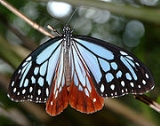
Parantica sita
Encyclopedia

Nymphalidae
The Nymphalidae is a family of about 5,000 species of butterflies which are distributed throughout most of the world. These are usually medium sized to large butterflies. Most species have a reduced pair of forelegs and many hold their colourful wings flat when resting. They are also called...
family.
Description
Wings elongate, almost as in Idea. Upperside of fore wing black or fuliginous black, with the following bluish-white subhyaline markings. A streak from base in interspace 1b, very broad streaks filling the basal three-fourths of interspace 1, and the whole of the cell, five very large quadrate discal spots, two long preapical streaks, three shorter streaks above them, a sub-terminal series of more or less rounded spots decreasing in size anteriorly and curved inwards opposite apex, and an incomplete subterminal series of smaller spots. Hind wing chestnut-red, with subhyaline streaks and spots as follows : streaks from base, not reaching the termen in interspaces 1 a and 1 b, two broad streaks united to near their apex in interspace 1, a streak filling the cell, and beyond it a discal series of large inwardly pointed elongate spots and incomplete ill-defined subterminal and terminal series of spots. Underside similar, the markings clearer and more complete. Antennae black; head and thorax black, spotted with white; abdomen from brown to bright ochraceous, beneath whitish. Male secondary sex-mark in form 2.Distribution
Along the Himalayas and into the Malayan region. N. Pakistan, Kashmir, N.India, Sikkim, Tibet, China, Taiwan, Korea, Japan, Malaya, Ussuri, Sakhalin, Indo-china.Life history
Larva: On emergence a dirty white colour with transverse lines on each segment, two somewhat long and thin tentacles or processes on the third, and two shorter ones on the twelfth segment. When full-fed the larva is about an inch and a half long, the ground-colour is of a pale yellowish green, with two rows of dorsal and a row on each side of lateral yellow spots, the head is black with grey spots on the face, the legs black.Pupa: pale emerald-green with golden-yellow spots. From eggs laid in September the imago issued in the following April.
Food-plants: Marsdenia roylei, Wright. Asclepiaceae. Asclepias curassavica
Asclepias curassavica
Asclepias curassavica, commonly called Mexican Butterfly Weed, Blood-flower, Scarlet Milkweed or, Tropical Milkweed, is a species of flowering plant in the dogbane family, Apocynaceae. It is native to the American tropics....
, Cynanchum caudatum, C. grandifolium, C. sublanceolatum, Hoya carnosa, Marsdenia tinctoria, M. tomentosa, Metaplexis spp., Tylophora aristolochioides, T. floribunda, T. japonica, T. ovata, T. tanakae.
Cultural references
- In March 1987 DPR Korea issued a postage stampPostage stampA postage stamp is a small piece of paper that is purchased and displayed on an item of mail as evidence of payment of postage. Typically, stamps are made from special paper, with a national designation and denomination on the face, and a gum adhesive on the reverse side...
depicting Parantica sita.
See also
- Danainae
- NymphalidaeNymphalidaeThe Nymphalidae is a family of about 5,000 species of butterflies which are distributed throughout most of the world. These are usually medium sized to large butterflies. Most species have a reduced pair of forelegs and many hold their colourful wings flat when resting. They are also called...
- List of butterflies of India
- List of butterflies of India (Nymphalidae)

